Documenting the dance Archivist Gayle DeGagné, keeper of RWB ephemera, says company's history is 'Winnipeg's history'
Read this article for free:
or
Already have an account? Log in here »
To continue reading, please subscribe:
Monthly Digital Subscription
$1 per week for 24 weeks*
- Enjoy unlimited reading on winnipegfreepress.com
- Read the E-Edition, our digital replica newspaper
- Access News Break, our award-winning app
- Play interactive puzzles
*Billed as $4.00 plus GST every four weeks. After 24 weeks, price increases to the regular rate of $19.00 plus GST every four weeks. Offer available to new and qualified returning subscribers only. Cancel any time.
Monthly Digital Subscription
$4.75/week*
- Enjoy unlimited reading on winnipegfreepress.com
- Read the E-Edition, our digital replica newspaper
- Access News Break, our award-winning app
- Play interactive puzzles
*Billed as $19 plus GST every four weeks. Cancel any time.
To continue reading, please subscribe:
Add Free Press access to your Brandon Sun subscription for only an additional
$1 for the first 4 weeks*
*Your next subscription payment will increase by $1.00 and you will be charged $16.99 plus GST for four weeks. After four weeks, your payment will increase to $23.99 plus GST every four weeks.
Read unlimited articles for free today:
or
Already have an account? Log in here »
Hey there, time traveller!
This article was published 06/09/2024 (400 days ago), so information in it may no longer be current.
As the Royal Winnipeg Ballet’s archivist, Gayle DeGagné is the keeper of many treasures.
In her office at the RWB’s studios on Graham Avenue, she pulls out a program — the ballet’s first, from 1939. The company was a new ballet club back then, making its public debut during a pageant in honour of King George VI and Queen Elizabeth’s visit to Winnipeg.
The cover of the program from
1939.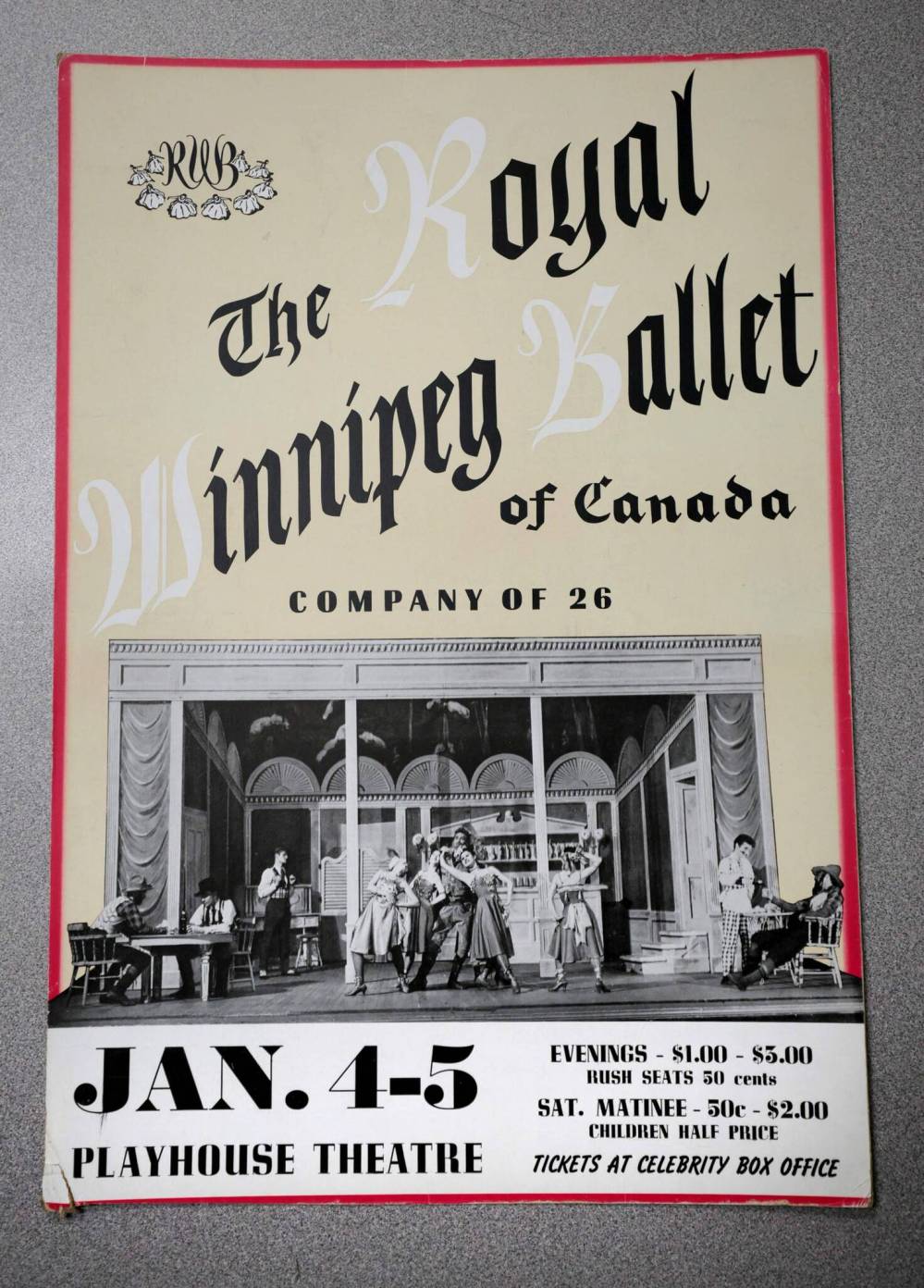
“This was a celebration that the whole city was involved in, but the ballet was asked to present two very short pieces for that production,” she says.
Those pieces, choreographed by RWB co-founder Gweneth Lloyd, were also meant to serve as a bit of Prairie promotion: Kilowatt Magic was about the marvels of hydro electricity and Grain was about Manitoba’s rippling fields.
Well, maybe. No records exist of Grain. But DeGagné has a photo from Kilowatt Magic featuring two dancers clad in strikingly modern superhero-esque costumes emblazoned with lightning bolts.
“This is one of the few surviving photographs we have of that ballet,” she says.
DeGagné also has a copy of the letter from a newly minted Queen Elizabeth II when she granted the Winnipeg Ballet the first Royal charter in the Commonwealth in 1953 (the original is with the Governor General). She has longtime artistic director Arnold Spohr’s Order of Canada.
The photographs, letters, promotional materials, posters, programs, costume sketches, costume designs, sheet music, stage designs and architectural blueprints in DeGagné’s care don’t just tell the story of a ballet company currently celebrating its 85th season.
“The RWB’s history is Winnipeg’s history.”
DeGagné, 50, took a bit of a circuitous route to the archives.
She originally trained to be a teacher, but after several years of substitute teaching, she was getting tired of the uncertainty of it.
Somebody told her about a joint internship between the Diocese of Rupertsland and the United Church archives, and figured she would be perfect for it. Growing up in St. Andrews, DeGagné always loved history, volunteering at Lower Fort Garry as a teenager. She also likes organizing and filing things.
“I don’t mind solitary work and I love doing the research. That’s my favourite part,” she says.
“And so on a whim, I applied for it, and I got it.”
The RWB’s Gayle DeGagné is fond of solitary work and research, which makes her a perfect archivist.
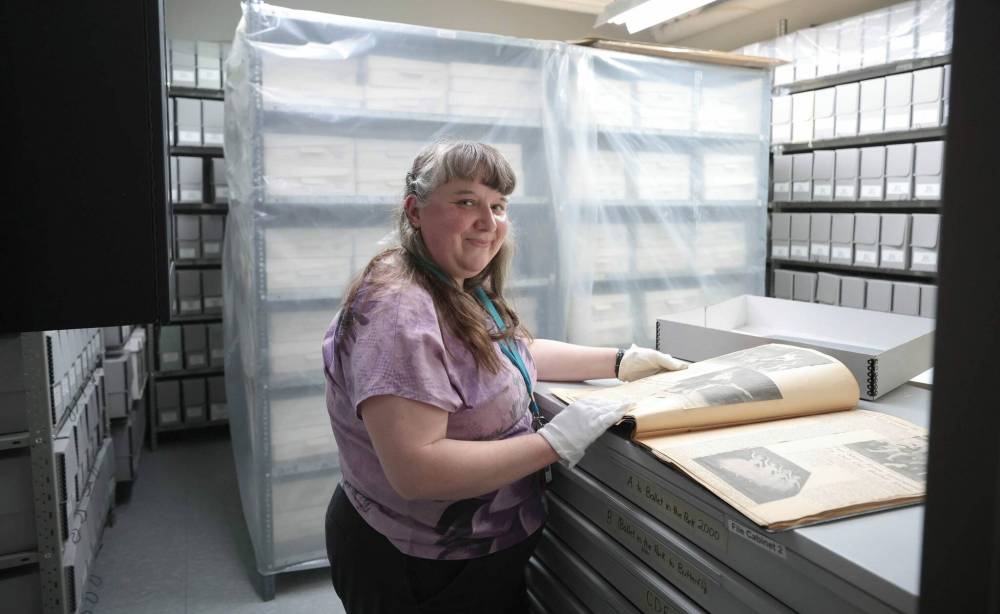
For the next seven years she worked in smaller archives as an archives assistant or archives technician before the ballet came calling.
The RWB’s Alumni Association had hired a professional archivist, Carole Boily, and she was looking for someone to take over. Boily knew of DeGagné and asked her if she wanted to work at the RWB Archives.
“I came here thinking that it was an interview and no, it was my first day of work,” she recalls with a laugh. That was 13 years ago.
Since then, DeGagné’s been working at meticulously protecting the items that many people might consider ephemera, removing staples from papers, photocopying yellowing newsprint onto acid-free paper, sorting photographs into acid-free sleeves and placing them in acid-free boxes.
“As long as they’re properly protected they’ll last forever,” she says.
Behind the Scenes
How is the stage lit? Who hangs the paintings? What happens in the dish pit? Behind the Scenes is a recurring series highlighting the important and often invisible work happening at arts and culture venues across Winnipeg.
Most of the archives she deals with are textual; costumes and digitized recordings of music, for example, belong to other departments.
Preservation isn’t just about having a historical record. It’s also about protection.
“(The archives) have been in jeopardy twice in our history,” DeGagné says.
The first was a devastating fire in 1954.
“We lost everything. Choreography, music, costumes, photographs, programs — everything. The only reason I have anything pre-1954 is because people had their own collections and gave them to the archives,” DeGagné says.
The second was a flood that began on the third floor of the RWB’s current building on Graham in 2015. But because everything was in archival boxes, they had very little loss.
DeGagné brings out one of the water-damaged boxes, its contents miraculously unscathed.
While her day-to-day work is often responding to requests from RWB staff and departments, part of DeGagné’s long-term work is digitizing the archives.
“The expectation is that everything is digitized and ready to go right away — that you can go online and collect it, and that’s certainly not the case,” she says.
A copy of the letter in which Queen Elizabeth
II granted the Winnipeg Ballet the first Royal
charter in the Commonwealth in 1953.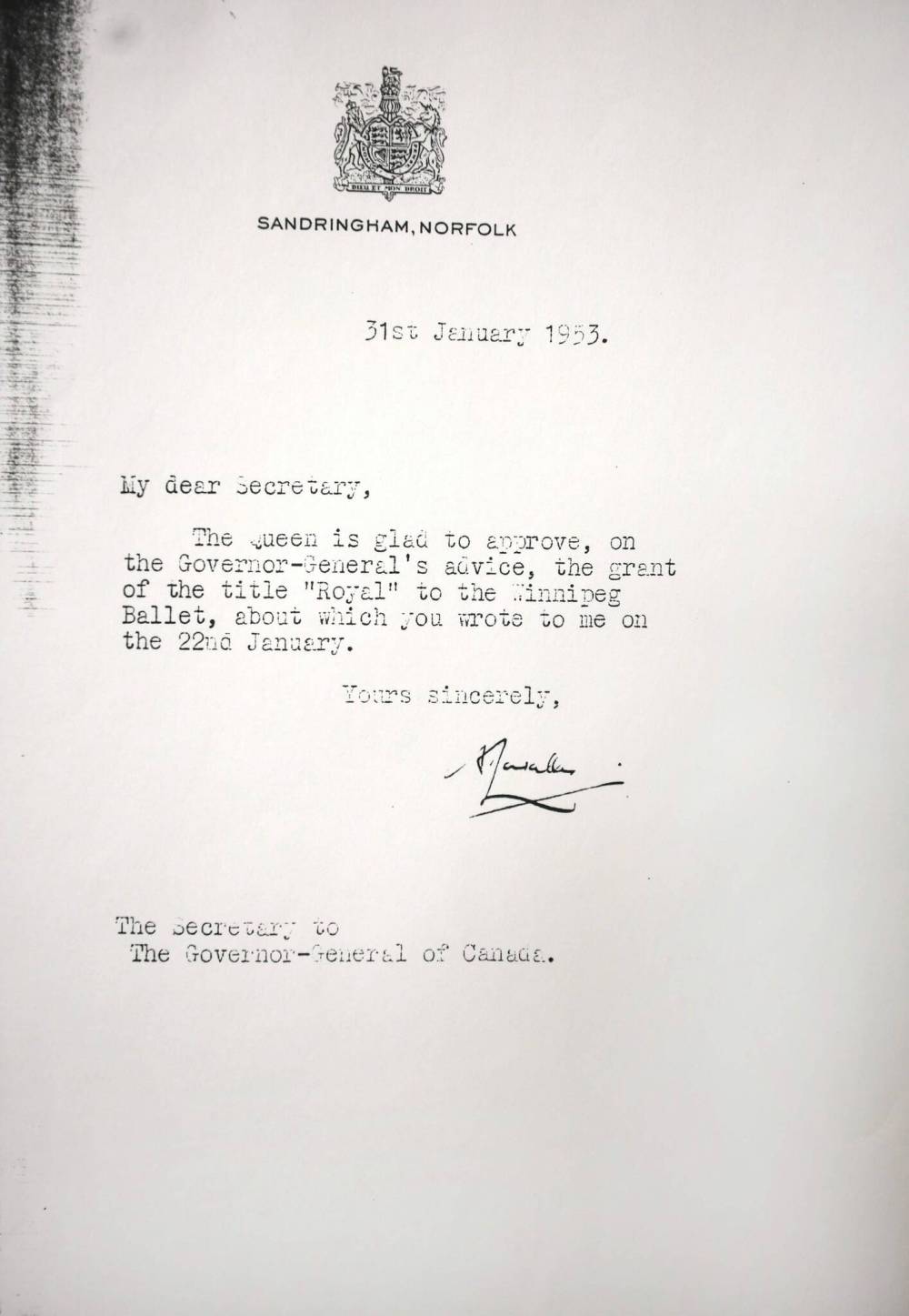
Because paper and photographs can be preserved in a way that ensures their longevity, her attention is currently on audio-visual material — particularly all the VHS tapes, which don’t hold up well. The RWB received a grant from Thomas Sill Foundation and has teamed up with Video Pool to digitize the many boxes of films and tapes.
Other long-term projects include the herculean task of “indexing the board minutes, the programs and the Alumni Association minutes, just for any references of subjects and ballets and things like that.”
Oh, and newspaper articles. So many newspaper articles.
“As you can imagine, that’s the longest one because it’s from 1939 onward. I started years ago and I’m still working on it.”
DeGagné’s own institutional knowledge is vast. She leads many building tours and people can’t stump her on trivia. But she can also nimbly respond to requests. You need a random photo from a ballet that was mounted in the 1970s? Ask Gayle. You want to put together a social media post that includes a fun historical fact about the company? Ask Gayle.
Or, let’s say you’re Winnipeg Symphony Orchestra associate conductor Julian Pellicano and social-distancing mandates owing to a global pandemic have halved your orchestra. Ask Gayle.
“We actually already had small orchestra parts written out here from years ago, and he used those as this guide — and he thanked me publicly for that, too,” she says with a smile.
How does it feel to fulfil a request like that?
“It’s very satisfying.”
Longtime RWB artistic director Arnold
Spohr’s Order of Canada medals from 2004
(left) and 1970.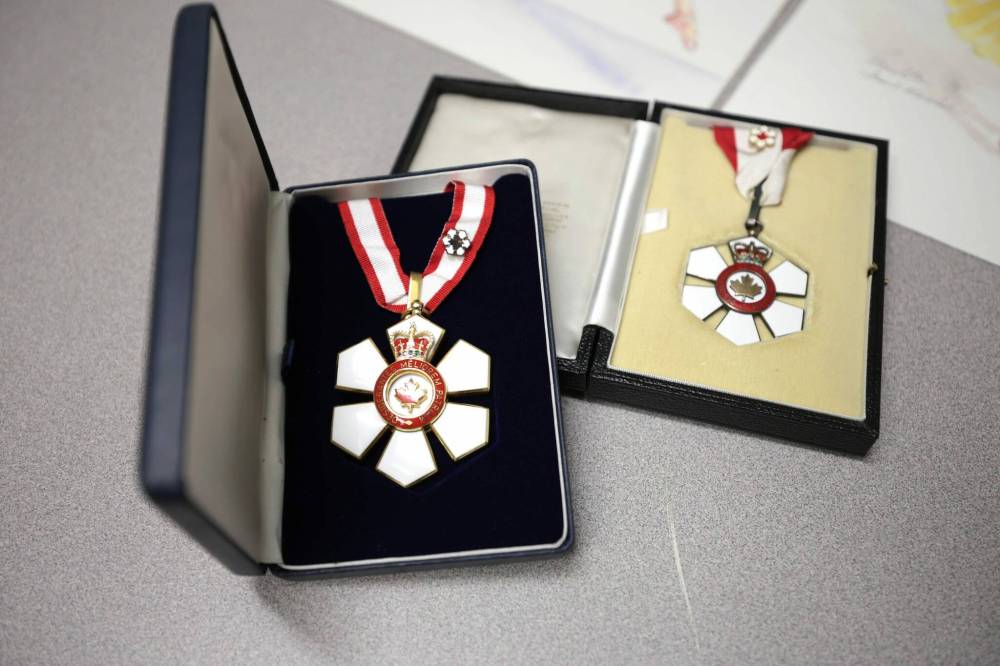
Archive awareness has been a challenge in DeGagné’s work. Put another way, she doesn’t want you to throw away that old RWB program. She wants you to bring it to her.
“That’s been a long haul. It’s come a very long way since I first started here — people now know to come to the archives to give me things. I automatically get two programs and two posters from each production now,” she says.
And sometimes a little awareness can lead to big discoveries.
The RWB’s archives contain a program from
1939, when the new ballet made its
public debut.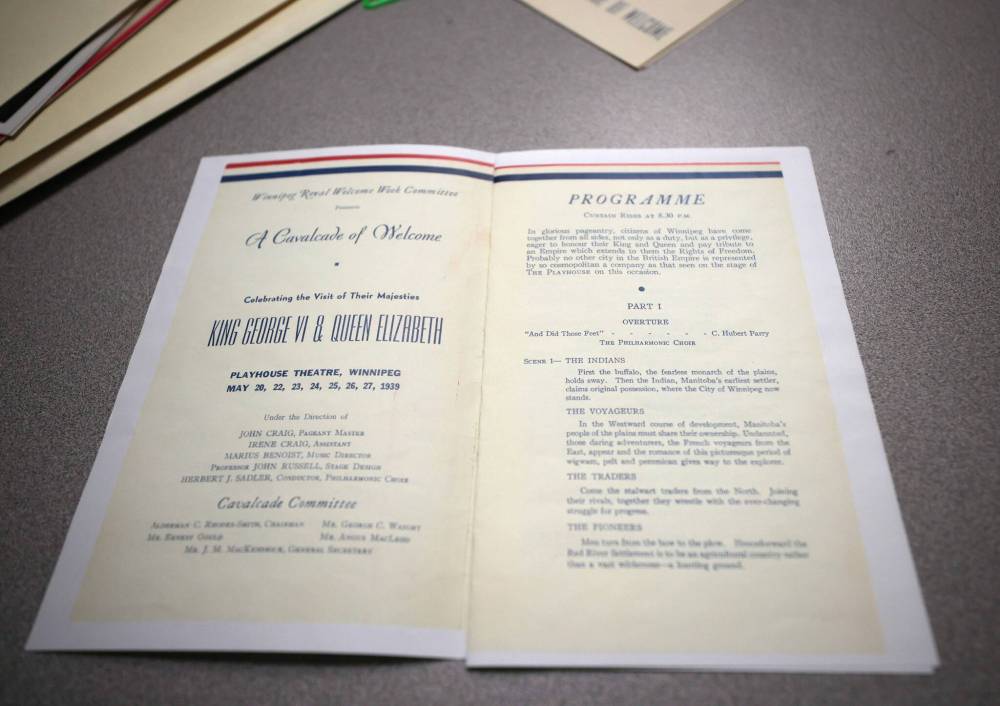
Last summer, DeGagné was doing research on the Andy Warhol prints that hang in the RWB’s main lobby on Graham.
“I was able to find within our own records when we got them, and what the conditions were and all of this — and I started noticing that we had other paintings that were given to the building that I’ve never seen.”
In particular: a set of six works by Winnipeg-born painter Jack Markell that were made for the RWB in the 1950s.
So, DeGagné did a Missing Person-style engagement campaign in the building — and it worked.
“I found all six of them,” she says.
Only three are physically in the building. They were found in the warehouse and offered to the RWB Student Living Centre to hang on their walls. “Two are with an RWB alum in New Brunswick and a third is with an RWB alum in Vancouver (who was the subject of the painting),” she says.
Mystery solved.
jen.zoratti@winnipegfreepress.com

Jen Zoratti is a columnist and feature writer working in the Arts & Life department, as well as the author of the weekly newsletter NEXT. A National Newspaper Award finalist for arts and entertainment writing, Jen is a graduate of the Creative Communications program at RRC Polytech and was a music writer before joining the Free Press in 2013. Read more about Jen.
Every piece of reporting Jen produces is reviewed by an editing team before it is posted online or published in print – part of the Free Press‘s tradition, since 1872, of producing reliable independent journalism. Read more about Free Press’s history and mandate, and learn how our newsroom operates.
Our newsroom depends on a growing audience of readers to power our journalism. If you are not a paid reader, please consider becoming a subscriber.
Our newsroom depends on its audience of readers to power our journalism. Thank you for your support.
History
Updated on Friday, September 6, 2024 7:55 PM CDT: Adds flood year


